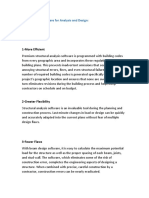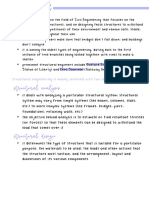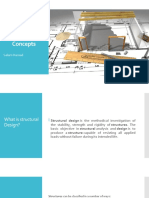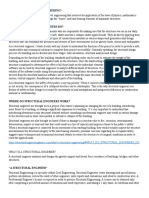0% found this document useful (0 votes)
27 views9 pagesStructural Analysis
The document discusses the benefits and uses of structured analysis in civil engineering, highlighting its ability to improve project efficiency, address client needs, and enhance risk analysis. It emphasizes the importance of creating updateable models and managing projects effectively from a solid foundation. Additionally, it underscores the critical role of structural design in ensuring the safety and durability of constructions.
Uploaded by
Arijit MandalCopyright
© © All Rights Reserved
We take content rights seriously. If you suspect this is your content, claim it here.
Available Formats
Download as PDF, TXT or read online on Scribd
0% found this document useful (0 votes)
27 views9 pagesStructural Analysis
The document discusses the benefits and uses of structured analysis in civil engineering, highlighting its ability to improve project efficiency, address client needs, and enhance risk analysis. It emphasizes the importance of creating updateable models and managing projects effectively from a solid foundation. Additionally, it underscores the critical role of structural design in ensuring the safety and durability of constructions.
Uploaded by
Arijit MandalCopyright
© © All Rights Reserved
We take content rights seriously. If you suspect this is your content, claim it here.
Available Formats
Download as PDF, TXT or read online on Scribd
/ 9





























































